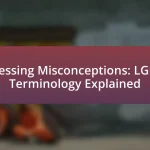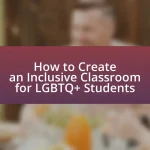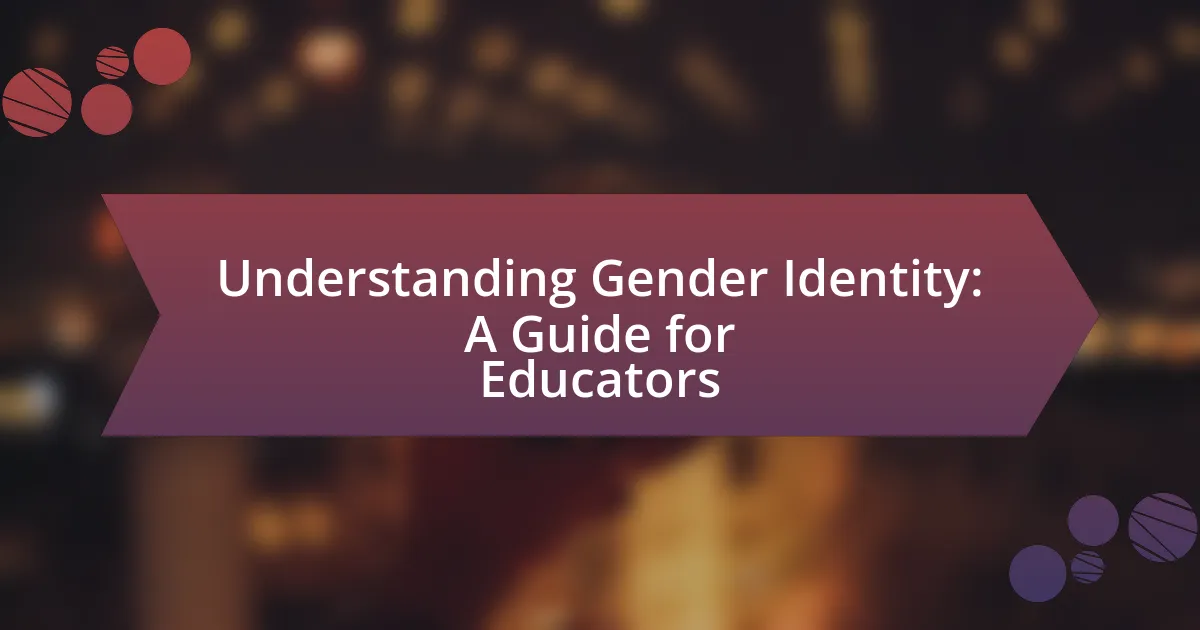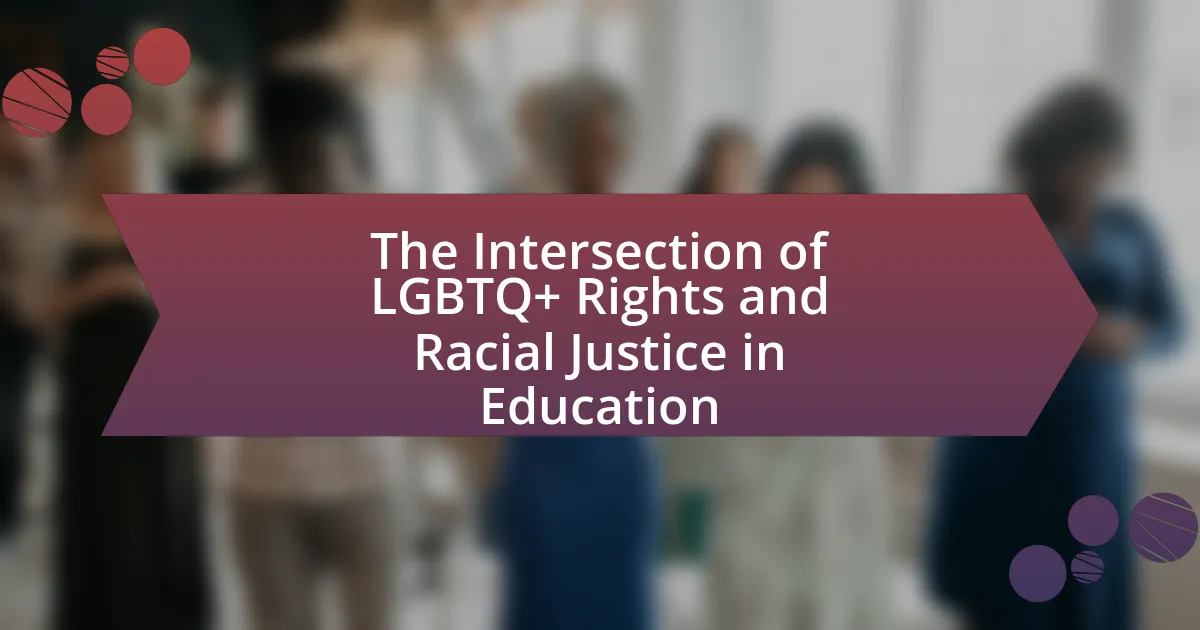The article examines the global landscape of LGBTQ+ rights and education, highlighting significant disparities across regions. It details the evolution of LGBTQ+ rights, from historical criminalization to contemporary legal protections, and discusses key events that have shaped these rights, such as the Stonewall Riots. The article also explores the influence of cultural attitudes on LGBTQ+ rights, the critical role of education in promoting acceptance, and the challenges faced by LGBTQ+ individuals in various regions. Additionally, it addresses the impact of legal frameworks, social stigmas, and the role of international organizations and grassroots movements in advocating for LGBTQ+ rights and education.

What is the Global Landscape of LGBTQ+ Rights and Education?
The global landscape of LGBTQ+ rights and education varies significantly across different regions, with some countries offering robust protections and inclusive educational frameworks, while others maintain discriminatory laws and practices. For instance, as of 2023, countries like Canada and the Netherlands have comprehensive legal protections for LGBTQ+ individuals, including marriage equality and anti-discrimination laws, alongside inclusive educational policies that promote LGBTQ+ awareness in schools. Conversely, nations such as Saudi Arabia and Uganda impose severe penalties for same-sex relationships and lack any formal LGBTQ+ education, often leading to widespread discrimination and violence against LGBTQ+ individuals. According to the International Lesbian, Gay, Bisexual, Trans and Intersex Association (ILGA), 69 countries still criminalize same-sex relationships, highlighting the stark disparities in LGBTQ+ rights globally.
How have LGBTQ+ rights evolved globally over time?
LGBTQ+ rights have evolved significantly over time, transitioning from criminalization and social stigma to increasing recognition and legal protections in many countries. Historically, many societies viewed homosexuality as a crime, with laws enforcing severe penalties; for example, in the early 20th century, homosexuality was illegal in most parts of the world. The mid-20th century saw the emergence of LGBTQ+ rights movements, notably the Stonewall Riots in 1969, which catalyzed activism in the United States and inspired global movements.
By the late 20th and early 21st centuries, numerous countries began decriminalizing homosexuality, with the Netherlands becoming the first country to legalize same-sex marriage in 2001. As of 2023, over 30 countries have legalized same-sex marriage, and many others have enacted anti-discrimination laws protecting LGBTQ+ individuals. However, challenges remain, as some regions still enforce punitive laws against LGBTQ+ individuals, highlighting a complex global landscape where rights vary widely.
What historical events have shaped LGBTQ+ rights?
Key historical events that have shaped LGBTQ+ rights include the Stonewall Riots of 1969, which marked a pivotal moment in the fight for LGBTQ+ equality in the United States, leading to the formation of various advocacy groups. The American Psychiatric Association’s decision in 1973 to remove homosexuality from its Diagnostic and Statistical Manual of Mental Disorders was a significant step in de-stigmatizing LGBTQ+ identities. Additionally, the AIDS crisis in the 1980s galvanized activism and awareness, resulting in increased visibility and advocacy for LGBTQ+ rights. The legalization of same-sex marriage in various countries, starting with the Netherlands in 2001, further solidified legal recognition and rights for LGBTQ+ individuals. These events collectively contributed to the ongoing struggle for equality and acceptance worldwide.
How do cultural attitudes influence the evolution of these rights?
Cultural attitudes significantly influence the evolution of LGBTQ+ rights by shaping societal norms and legal frameworks. For instance, in countries where cultural acceptance of LGBTQ+ individuals is high, such as Canada and the Netherlands, legal protections and rights for LGBTQ+ communities have advanced rapidly, including marriage equality and anti-discrimination laws. Conversely, in regions where cultural attitudes are predominantly conservative, such as parts of Africa and the Middle East, LGBTQ+ rights remain severely restricted, often resulting in criminalization and social stigma. This correlation between cultural attitudes and legal evolution is evident in the Global Acceptance Index, which shows that nations with progressive cultural views tend to enact more comprehensive LGBTQ+ rights legislation, reflecting the direct impact of societal beliefs on the legal landscape.
What role does education play in promoting LGBTQ+ rights?
Education plays a crucial role in promoting LGBTQ+ rights by fostering awareness, understanding, and acceptance of diverse sexual orientations and gender identities. Through comprehensive curricula that include LGBTQ+ history, issues, and contributions, educational institutions can challenge stereotypes and reduce discrimination. Research indicates that inclusive education leads to safer school environments; for instance, a study by GLSEN found that LGBTQ+ students who attended schools with inclusive curricula reported feeling safer and more supported. Furthermore, education equips individuals with the knowledge to advocate for their rights and the rights of others, thereby contributing to broader societal change.
How can education systems integrate LGBTQ+ topics effectively?
Education systems can effectively integrate LGBTQ+ topics by incorporating inclusive curricula that reflect diverse sexual orientations and gender identities. This can be achieved through the development of educational materials that include LGBTQ+ history, literature, and contributions to society, ensuring representation in subjects like social studies and health education. Research indicates that inclusive education fosters a safer environment for all students; for instance, a study by GLSEN found that LGBTQ+ inclusive curricula significantly reduce bullying and harassment in schools. Additionally, training educators on LGBTQ+ issues and promoting policies that support diversity can further enhance the integration of these topics, creating a more accepting and informed school culture.
What are the benefits of LGBTQ+ inclusive education?
LGBTQ+ inclusive education promotes acceptance and understanding, leading to a safer and more supportive environment for all students. This educational approach reduces bullying and discrimination, as evidenced by a study from GLSEN, which found that schools with inclusive curricula reported lower rates of harassment based on sexual orientation and gender identity. Furthermore, LGBTQ+ inclusive education enhances academic performance by fostering a sense of belonging, as students who feel accepted are more likely to engage positively in their learning environment.
What challenges do LGBTQ+ individuals face in different regions?
LGBTQ+ individuals face significant challenges that vary by region, including legal discrimination, social stigma, and violence. In regions such as the Middle East and parts of Africa, homosexuality is criminalized, leading to imprisonment or even death, as seen in countries like Uganda and Iran. In contrast, while many Western nations have made strides in legal protections, LGBTQ+ individuals still encounter discrimination in employment and healthcare, as evidenced by studies showing higher rates of mental health issues among LGBTQ+ populations in the United States due to societal rejection. Additionally, cultural attitudes in regions like Eastern Europe often perpetuate homophobia, resulting in harassment and violence against LGBTQ+ individuals, as reported by organizations like ILGA-Europe. These challenges highlight the diverse and complex landscape of LGBTQ+ rights and experiences globally.
How do legal frameworks impact LGBTQ+ rights in various countries?
Legal frameworks significantly impact LGBTQ+ rights in various countries by determining the legal recognition, protection, and rights afforded to LGBTQ+ individuals. For instance, countries like Canada and the Netherlands have comprehensive anti-discrimination laws and legal recognition of same-sex marriage, which promote equality and protect LGBTQ+ individuals from discrimination. In contrast, nations such as Saudi Arabia and Uganda have laws that criminalize same-sex relationships, leading to widespread discrimination and violence against LGBTQ+ individuals. According to the International Lesbian, Gay, Bisexual, Trans and Intersex Association (ILGA), as of 2021, 69 countries still criminalize same-sex relationships, illustrating how legal frameworks can either uphold or violate human rights for LGBTQ+ communities.
What social stigmas persist against LGBTQ+ communities worldwide?
Social stigmas against LGBTQ+ communities worldwide include discrimination, violence, and negative stereotypes. These stigmas manifest in various forms, such as legal inequalities, social ostracism, and cultural taboos. For instance, in many countries, same-sex relationships are criminalized, leading to legal repercussions for LGBTQ+ individuals. According to a 2021 report by ILGA World, 69 countries still have laws that criminalize same-sex relationships, which perpetuates societal discrimination and violence. Additionally, negative stereotypes often portray LGBTQ+ individuals as immoral or deviant, contributing to widespread bullying and mental health issues within these communities. These persistent stigmas hinder the acceptance and rights of LGBTQ+ individuals globally.

How do Different Regions Approach LGBTQ+ Rights and Education?
Different regions approach LGBTQ+ rights and education with varying degrees of acceptance and legal frameworks. For instance, Western Europe, particularly countries like the Netherlands and Germany, has progressive laws supporting LGBTQ+ rights, including same-sex marriage and anti-discrimination policies, alongside comprehensive educational programs that promote LGBTQ+ awareness in schools. In contrast, many regions in Africa and the Middle East impose strict laws against homosexuality, with countries like Uganda and Saudi Arabia enforcing severe penalties, including imprisonment or even death, and lacking any formal LGBTQ+ education in their curricula. This disparity highlights the influence of cultural, religious, and political factors on the acceptance and education surrounding LGBTQ+ issues globally.
What are the key differences in LGBTQ+ rights across continents?
LGBTQ+ rights vary significantly across continents, with notable differences in legal recognition, social acceptance, and protections against discrimination. In North America, countries like Canada and the United States have legalized same-sex marriage and implemented anti-discrimination laws, while in South America, nations such as Argentina and Uruguay have made similar advancements, but others lag behind. In Europe, many countries have comprehensive LGBTQ+ rights, including marriage equality and adoption rights, although Eastern European nations often exhibit less acceptance and legal protections. In Africa, LGBTQ+ individuals face severe discrimination, with many countries criminalizing same-sex relationships, while in Asia, rights vary widely; for instance, Taiwan has legalized same-sex marriage, contrasting sharply with countries like Saudi Arabia, where homosexuality is punishable by death. Oceania shows a mixed landscape, with Australia legalizing same-sex marriage, while some Pacific Island nations maintain colonial-era laws against homosexuality. These differences highlight the complex interplay of cultural, legal, and social factors influencing LGBTQ+ rights globally.
How do North American policies compare to those in Europe?
North American policies on LGBTQ+ rights generally prioritize individual freedoms and legal protections, while European policies often emphasize comprehensive social inclusion and anti-discrimination measures. For instance, same-sex marriage is legal in most North American states, similar to many European countries; however, the U.S. Supreme Court’s 2015 ruling in Obergefell v. Hodges established marriage equality federally, whereas European nations have varied timelines and approaches to legalization. Furthermore, European countries typically have more robust anti-discrimination laws and social welfare systems that support LGBTQ+ individuals, as seen in the European Union’s Charter of Fundamental Rights, which explicitly prohibits discrimination based on sexual orientation. This contrast highlights a broader trend where European policies tend to integrate LGBTQ+ rights within a framework of social justice, while North American policies often focus on legal recognition and individual rights.
What unique challenges do LGBTQ+ individuals face in Asia and Africa?
LGBTQ+ individuals in Asia and Africa face unique challenges including legal discrimination, social stigma, and violence. In many countries within these regions, homosexuality is criminalized; for instance, in countries like Uganda and Nigeria, laws impose severe penalties for same-sex relationships. Socially, LGBTQ+ individuals often encounter familial rejection and community ostracism, which can lead to mental health issues and increased vulnerability to violence. According to a 2020 report by ILGA (International Lesbian, Gay, Bisexual, Trans and Intersex Association), 69 countries in the world still criminalize same-sex relationships, with a significant number located in Africa and Asia. Additionally, cultural norms in many societies prioritize heteronormativity, further marginalizing LGBTQ+ individuals and limiting their access to healthcare, education, and employment opportunities.
How do international organizations influence LGBTQ+ rights?
International organizations influence LGBTQ+ rights by establishing global norms, providing funding, and advocating for policy changes. For instance, the United Nations has adopted resolutions that promote the decriminalization of homosexuality and combat discrimination based on sexual orientation and gender identity. Additionally, organizations like Human Rights Watch and Amnesty International conduct research and publish reports that highlight human rights abuses against LGBTQ+ individuals, pressuring governments to improve their laws and practices. These actions create accountability and encourage countries to align their policies with international human rights standards, thereby advancing LGBTQ+ rights globally.
What role do NGOs play in advocating for LGBTQ+ education?
NGOs play a crucial role in advocating for LGBTQ+ education by promoting awareness, providing resources, and influencing policy changes. These organizations often develop educational programs that address LGBTQ+ issues, aiming to create inclusive environments in schools and communities. For instance, NGOs like GLSEN in the United States have implemented initiatives that train educators on LGBTQ+ inclusivity, which has been shown to improve school climates for LGBTQ+ students. Additionally, NGOs engage in lobbying efforts to ensure that LGBTQ+ topics are included in educational curricula, thereby fostering understanding and acceptance. Their advocacy is supported by research indicating that comprehensive LGBTQ+ education can reduce bullying and discrimination, ultimately leading to better mental health outcomes for LGBTQ+ youth.
How effective are global campaigns in changing local laws?
Global campaigns are highly effective in changing local laws, particularly in the context of LGBTQ+ rights. For instance, the global push for marriage equality has led to significant legal changes in various countries, such as the legalization of same-sex marriage in countries like Ireland and Australia, influenced by international advocacy and public opinion shifts. Research by the Williams Institute indicates that global advocacy efforts can lead to increased awareness and support for LGBTQ+ rights, resulting in legislative changes in local jurisdictions. Additionally, organizations like Human Rights Campaign and ILGA have documented cases where international pressure and solidarity have prompted local governments to reconsider discriminatory laws, demonstrating the tangible impact of global campaigns on local legal frameworks.

What Future Trends Can We Expect in LGBTQ+ Rights and Education?
Future trends in LGBTQ+ rights and education indicate a growing acceptance and integration of LGBTQ+ issues into mainstream curricula and policies. Increasingly, educational institutions are adopting inclusive practices, such as implementing comprehensive sex education that addresses diverse sexual orientations and gender identities. For instance, a 2021 report by the Human Rights Campaign highlighted that 92% of LGBTQ+ youth reported feeling safer in schools that have inclusive policies. Additionally, legal advancements, such as the legalization of same-sex marriage in numerous countries, are likely to influence educational content, promoting awareness and understanding of LGBTQ+ history and rights. This trend is supported by a global shift towards recognizing LGBTQ+ rights as human rights, as evidenced by the United Nations’ ongoing initiatives to promote equality and combat discrimination.
How is technology shaping the future of LGBTQ+ advocacy?
Technology is significantly shaping the future of LGBTQ+ advocacy by enhancing communication, mobilizing communities, and increasing visibility. Digital platforms enable activists to connect globally, share resources, and organize events, which has been crucial in campaigns like the global #LoveIsLove movement that gained traction through social media. Furthermore, data analytics tools allow organizations to track progress on LGBTQ+ rights and identify areas needing attention, as seen in reports from the Human Rights Campaign that utilize technology to assess legislative changes. Additionally, virtual reality and online education platforms are providing immersive experiences that foster understanding and empathy, thereby promoting inclusivity.
What impact do social media platforms have on LGBTQ+ awareness?
Social media platforms significantly enhance LGBTQ+ awareness by providing a space for visibility, community building, and information dissemination. These platforms allow LGBTQ+ individuals to share their experiences, advocate for rights, and connect with allies, thereby fostering a greater understanding of LGBTQ+ issues. For instance, a study by the Pew Research Center found that 70% of LGBTQ+ adults in the U.S. reported that social media has been important for their ability to connect with others in the community. This connectivity leads to increased awareness and support for LGBTQ+ rights, as users engage with content that educates and informs about diverse sexual orientations and gender identities.
How can online education resources support LGBTQ+ rights?
Online education resources can support LGBTQ+ rights by providing accessible information, fostering awareness, and promoting inclusivity. These resources, such as online courses, webinars, and educational platforms, offer comprehensive content on LGBTQ+ history, rights, and issues, which can help combat misinformation and stereotypes. For instance, studies show that education significantly reduces prejudice; a report by the Human Rights Campaign indicates that inclusive curricula lead to more supportive environments for LGBTQ+ individuals. By equipping learners with knowledge and understanding, online education resources play a crucial role in advocating for and advancing LGBTQ+ rights globally.
What strategies can be implemented to improve LGBTQ+ rights globally?
To improve LGBTQ+ rights globally, strategies such as legal reforms, education initiatives, and international advocacy must be implemented. Legal reforms should focus on decriminalizing same-sex relationships and enacting anti-discrimination laws, as evidenced by countries like Malta, which has made significant strides in LGBTQ+ rights through comprehensive legislation. Education initiatives can promote awareness and acceptance, as seen in the implementation of inclusive curricula in schools, which has been shown to reduce bullying and discrimination. International advocacy, including pressure from organizations like the United Nations, can help hold countries accountable for human rights violations against LGBTQ+ individuals, as demonstrated by the Universal Periodic Review process that assesses human rights practices globally.
How can grassroots movements enhance LGBTQ+ education initiatives?
Grassroots movements can enhance LGBTQ+ education initiatives by mobilizing community support and fostering inclusive curricula. These movements often engage local stakeholders, including educators, parents, and students, to advocate for comprehensive LGBTQ+ topics in educational settings. For example, the Gay, Lesbian and Straight Education Network (GLSEN) has successfully implemented programs that promote safe and affirming schools, demonstrating that grassroots advocacy can lead to policy changes and increased awareness. Additionally, grassroots efforts can provide resources and training for educators, ensuring they are equipped to address LGBTQ+ issues effectively, which is crucial for creating an inclusive learning environment.
What best practices can be adopted from successful LGBTQ+ advocacy efforts?
Successful LGBTQ+ advocacy efforts can adopt best practices such as building coalitions, utilizing data-driven strategies, and engaging in grassroots mobilization. Building coalitions among diverse groups enhances the strength and reach of advocacy efforts, as seen in the collaboration between LGBTQ+ organizations and allies during the marriage equality movement, which significantly increased public support. Data-driven strategies, including the use of research and statistics to highlight disparities faced by LGBTQ+ individuals, have proven effective in influencing policy changes; for instance, the Human Rights Campaign’s reports on workplace discrimination have led to legislative reforms. Grassroots mobilization empowers local communities, as demonstrated by the Stonewall Riots, which galvanized widespread activism and awareness. These practices collectively contribute to more effective advocacy and positive outcomes for LGBTQ+ rights.
What practical steps can individuals take to support LGBTQ+ rights?
Individuals can support LGBTQ+ rights by actively advocating for inclusive policies and practices. This can be achieved by participating in local and national campaigns that promote equality, such as signing petitions or attending rallies. Additionally, individuals can educate themselves and others about LGBTQ+ issues, fostering understanding and acceptance within their communities. Supporting LGBTQ+ organizations through donations or volunteering also contributes to the advancement of rights and resources for the community. Research indicates that public support for LGBTQ+ rights has increased, with a 2021 Gallup poll showing that 70% of Americans support same-sex marriage, highlighting the effectiveness of grassroots advocacy in shifting societal attitudes.





